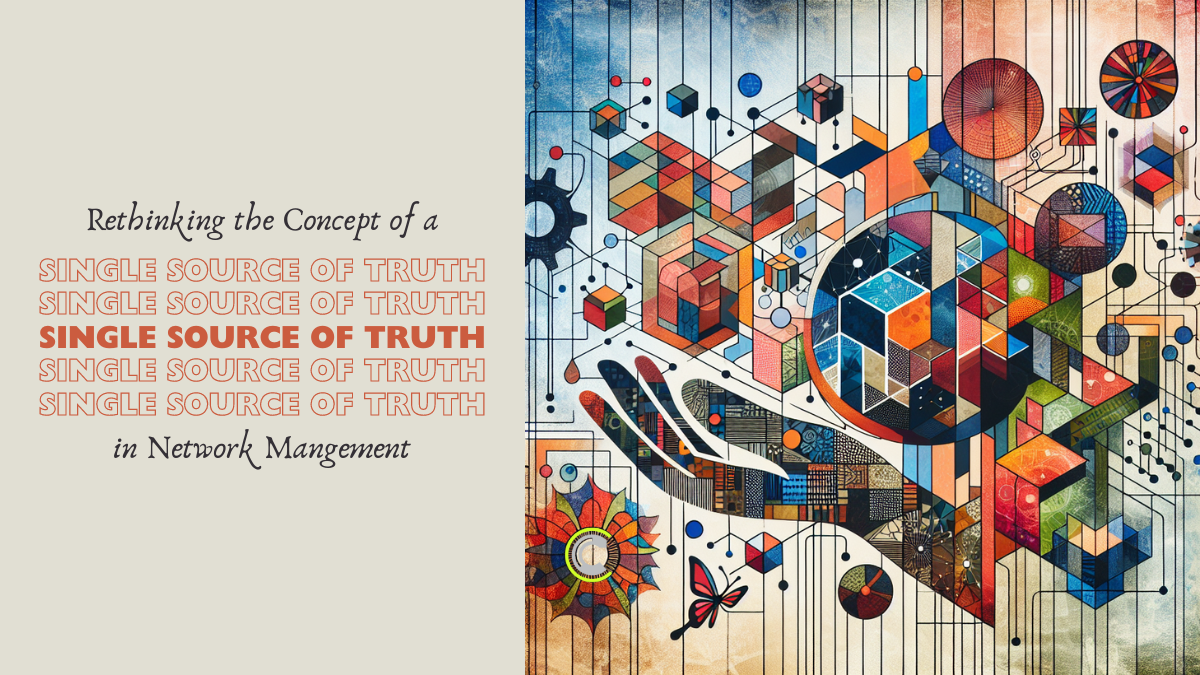
The concept of a single source of truth has often been touted as integral to network automation. And for good reason. However, today, we are challenging this notion, advocating for a more nuanced understanding that better reflects the realities of modern network infrastructures. This expanded exploration delves into why the concept of a single source of truth can be both misleading and insufficient, and how embracing a multifaceted approach can drive more effective network management strategies.
The Reality of Multiple Sources of Truth
The pursuit of a single source of truth often oversimplifies the intricate web of data sources that underpin network management. Networks inherently comprise multiple sources of truth, for example: device configurations, configuration management databases (CMDBs), configuration templates, and let’s not forget state data. Each of these elements is vital in painting a comprehensive picture of the network’s health and operational status.
Even having a single CMDB/IPAM/DCIM/etc. is not always possible, nor desirable. For example, in the world of interconnection, PeeringDB is a great source of data about third party networks and facilities that will always be independent of any internal data set.
It’s more about coordination than consolidation. Each source provides a different lens on the network, and together, they create a cohesive narrative. This integration of various data streams is essential rather than attempting to distill them into a singular entity.
The Essential Role of State Data
State data is indispensable in network management, offering insights into the real-time operational status of the network. Unlike configuration data, which outlines the intended setup of network devices, state data reflects the actual functioning and performance of these devices. It essentially serves as the network’s pulse, providing a true reflection of current operations. While configurations tell us what should be happening, state data tells us what is actually happening.
This dynamic information is crucial for troubleshooting and optimizing network operations. By continuously monitoring state data, network engineers can swiftly identify and address discrepancies between expected and actual performance, thereby enhancing the network’s reliability and efficiency.
The Importance of Historical Data
A thorough understanding of network behavior requires not only current data but also historical context. Versioning and time-series databases play a pivotal role in maintaining a record of past configurations and state data, effectively transforming history into another source of truth.
By tracking changes over time, organizations can analyze trends, predict potential issues, and make informed decisions based on historical insights. Historical data acts as our guide through the labyrinth of network changes. It helps us learn from the past to better prepare for the future.
Being able to answer questions like, “what changed around the time of this incident,” is crucial to successful troubleshooting - and those changes are never guaranteed to be configuration changes. It is invaluable to be able to see when a peer changed the routes they are advertising, or when an optic started to overheat, or when an MPLS path moved to a new link, etc.
Challenging the Term ‘Single Source of Truth’
We’ve come to the conclusion that while the motivation was good, term ‘single source of truth’ is simply inadequate in encapsulating the complexity of network management. As our friend Dinesh Dutt recently pointed out to us; systems engineers, who encounter similar challenges in other domains, rarely use this terminology. Instead, they focus on data management and integrity without attempting to simplify their frameworks to a singular notion.
The intention was to streamline network changes through centralized automation, but labeling it as a ‘single source’ doesn’t do justice to the complexity involved. It’s about harmonizing multiple truths to achieve a seamless operation.
This perspective advocates for a shift from a static, monolithic approach to a dynamic, integrated one that acknowledges the interplay between various data elements - while still ensuring that configuration changes are made in appropriate ways following well-vetted procedures.
Embracing Intent-Based Networking
Despite the shortcomings of the ‘single source of truth’ (SSoT) terminology, the principles of SSoT architectures and intent-based networking (IBN) remain highly relevant.
This approach revolutionizes network management by: - Ensuring that your documentation is always up to date (because the network is configured through changes to the documentation) - Ensuring that policy and process is always followed (because orchestration pipelines validate changes before they are implemented on production infrastructure) - Ensuring that network operations are aligned with strategic business objectives (primarily through abstraction and declarative instead of imperative models)
The combined assurance is that networks are not only operational but also strategically aligned with organizational goals (not to mention easier to troubleshoot). Intent-based networking translates high-level business intentions into actionable network configurations. Even if we move beyond the term ‘single source of truth,’ the need for strategic alignment remains.
Conclusion
Navigating the complexities of modern network management requires moving beyond the simplistic notion of a single source of truth. By embracing multiple sources, injecting needed validation, and understanding the critical roles of both state and historical data, organizations can develop a more robust and agile approach to network management.
This comprehensive perspective, as part of the adoption of intent-based networking, positions businesses to lead in network innovation and efficiency, ultimately driving superior outcomes in a rapidly changing technological landscape.
Through this expanded understanding, network professionals can better tackle the challenges of today’s complex infrastructures, ensuring that their networks not only meet current demands but are also poised to adapt to future innovations and disruptions.
Need help figuring all this out for your organization? FullCtl is at your service!